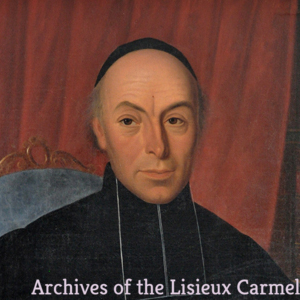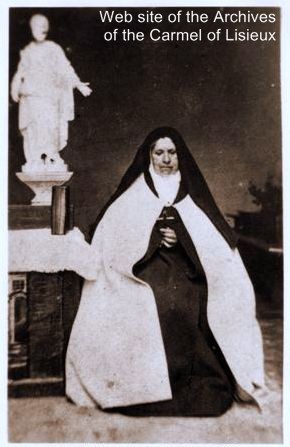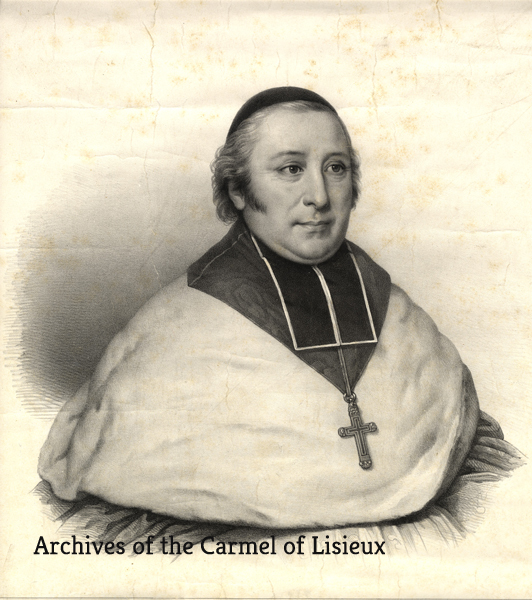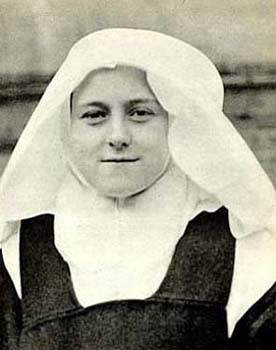Saint Therese of the Child Jesus
of the Holy Face
Entries in Sister Febronie of the Holy Childhood (1)
St. Therese of Lisieux and the influenza pandemic of 1892, part 5: the subprioress, Sister Febronie of the Holy Childhood
Sister Febronie of the Holy Childhood (1819-1892),
subprioress, the second to die during the pandemic
We left the Lisieux Carmel after the death of the first victim of the influenza epidemic, Sister Saint-Joseph of Jesus, who died on Saturday morning, January 2, 1892. Her funeral had been set for the morning of Tuesday, January 5, and her body laid out, according to custom, in the choir. But the evening before her funeral Mass God called another elder of the community, Sister Febronie of Jesus, the subprioress, who died at 8:00 p.m. on Monday, January 4th. The next morning Celine Martin wrote to her cousin, Jeanne LaNeele:
The poor Carmel is right now a prey to the influenza epidemic, the plague is raging there in full force. This morning we were at the burial of the religious who died on Saturday, and on Friday we shall return for another burial, that of the Mother Subprioress, who died last night. There are still two of the three sick ones whom they despair of saving, among them Sister Madeleine, aunt of Madame St. Benoît at the Abbey, and another religious whom I do not know. Up until now, it is the older ones who are leaving, but the young are also very sick. Pauline has been in bed for a few days now . . . [1]
Read the full text of this letter on the Web site of the Archives of the Carmel of Lisieux.
Let’s look first at a brief summary of Sister Febronie’s life. More details can be found on the page “Sister Febronie of the Holy Childhood” on the Web site of the Archives of the Carmel of Lisieux. I thank the Carmelites of Lisieux for sharing all this information.
Marie-Julie Malville
Marie-Julie Malville, known as Julie, was born in Paris on October 31, 1819, the daughter of a tailor. Her sister Pauline was born 16 months later. Their mother, Marie-Jeanne Paris, died when Julie was only five. At first the father had to entrust the two little girls to a friend of their mother’s, but he soon remarried and moved his family to Rouen, where Julie and Pauline were placed in a convent boarding school. Julie developed a passion for study; she did not want to leave her books even to play the customary games. Later the family moved to Lisieux, where Julie encountered Carmel.
 Fr. Pierre-Nicolas Sauvage, priest-founder of the Lisieux CarmAbout 1838, in the neighborhood of the Nouveau Monde, outside Lisieux and near Les Buissonnets, Fr. Pierre-Nicolas Sauvage, curate of Saint Jacques parish in Lisieux, would sometimes meet the two Malville girls and their mother returning from church. Thinking of the monastery he had just founded, he wondered whether one of them might be a future Carmelite. One day the two girls came to his confessional, and he became Julie’s spiritual director. When she learned that he was the priest-superior of the Carmelites, her early thoughts of religious life returned to her. Fearing that Julie's health would not support the austere rule of Carmel, Fr. Sauvage tried to persuade her against it, but finally he allowed her to present herself to the Carmelites. At the end of 1841 she was received as a visitor by the prioress, Mother Elizabeth of St. Louis, who had hardly blessed the candidate when she herself was called to God on January 3, 1842. Like Therese, Mother Elizabeth died of tuberculosis.
Fr. Pierre-Nicolas Sauvage, priest-founder of the Lisieux CarmAbout 1838, in the neighborhood of the Nouveau Monde, outside Lisieux and near Les Buissonnets, Fr. Pierre-Nicolas Sauvage, curate of Saint Jacques parish in Lisieux, would sometimes meet the two Malville girls and their mother returning from church. Thinking of the monastery he had just founded, he wondered whether one of them might be a future Carmelite. One day the two girls came to his confessional, and he became Julie’s spiritual director. When she learned that he was the priest-superior of the Carmelites, her early thoughts of religious life returned to her. Fearing that Julie's health would not support the austere rule of Carmel, Fr. Sauvage tried to persuade her against it, but finally he allowed her to present herself to the Carmelites. At the end of 1841 she was received as a visitor by the prioress, Mother Elizabeth of St. Louis, who had hardly blessed the candidate when she herself was called to God on January 3, 1842. Like Therese, Mother Elizabeth died of tuberculosis.  Mother Genevieve of St. Teresa, who received Julie Malville into the CarmelHer successor, Mother Genevieve of St. Teresa, received Julie on the day she was elected prioress: January 15, 1842. Julie was the eighth postulant since the Carmel had opened in 1838.
Mother Genevieve of St. Teresa, who received Julie Malville into the CarmelHer successor, Mother Genevieve of St. Teresa, received Julie on the day she was elected prioress: January 15, 1842. Julie was the eighth postulant since the Carmel had opened in 1838.
In Carmel: Sister Febronie
Julie, now Sister Febronie of the Holy Childhood, adapted well to Carmelite life. In her circular Mother Gonzague wrote that she
“was from her entrance a model of regularity, of silence and of piety. This was truly an interior soul who loved solitary life and to be hidden in God. Our good older Mothers recognizing the young religious as someone filled with qualities that bring joy and hope to the community, received her with happiness . . .”[2]
She received the habit on May 24, 1842 and professed her vows on July 15, 1843.  Francois Robin, bishop of BayeuxHer taking of the veil was postponed until October 27th so that the bishop, Francois Robin, might preside. Although the documents hint that M. Malville had not been eager to consent to his daughter’s entrance, at her taking of the veil the bishop noticed him at the grille asking Julie’s forgiveness and offering her his own. He was generous in gifts to the desperately poor community.
Francois Robin, bishop of BayeuxHer taking of the veil was postponed until October 27th so that the bishop, Francois Robin, might preside. Although the documents hint that M. Malville had not been eager to consent to his daughter’s entrance, at her taking of the veil the bishop noticed him at the grille asking Julie’s forgiveness and offering her his own. He was generous in gifts to the desperately poor community.
Sister Febronie was appointed by turns infirmarian, laundress, and dressmaker. In 1860, she was elected subprioress. In this role she served off and on for a total of 14 years; she was subprioress from Therese’s entrance until her own death. Mother Gonzague wrote that, as subprioress, Sister Febronie “was the happiness and joy of her Mother Prioresses, remaining always united with them in the same views and feelings.”[3] (These prioresses were Mother Genevieve and Mother Gonzague).
When the Franco-Prussian war of 1870 came close to Lisieux, the families of some of the nuns asked to be allowed to take their daughters home to keep them safe. Sister Febronie’s family, now living in Rennes, offered her refuge, but she preferred the Carmel of Rennes, which had already taken in the whole Carmelite community of Compiegne. There they preserved “a good remembrance” of her.[4]
Sister Therese as a novice and Sister Febronie
 Sister Therese of the Child Jesus as a novice, aged 16, January 1889In Story of a Soul, without naming Sister Febronie, Therese gives an account of their conversation during recreation. It was during her first two years in Carmel, when she was having difficulty confiding in her novice mistress, Marie of the Angels:
Sister Therese of the Child Jesus as a novice, aged 16, January 1889In Story of a Soul, without naming Sister Febronie, Therese gives an account of their conversation during recreation. It was during her first two years in Carmel, when she was having difficulty confiding in her novice mistress, Marie of the Angels:
It was only with great effort that I was able to take direction, for I had never become accustomed to speaking about my soul and I didn’t know how to express what was going on within it. One good old Mother understood one day what I was experiencing, and she said laughingly during recreation: “My child, it seems to me you don’t have very much to tell your Superiors.” “Why do you say that, Mother?” “Because your soul is extremely simple, but when you will be perfect, you will be even more simple; the closer one approaches to God, the simpler one becomes.” The good Mother was right . . . . [5]
Sister Febronie during the influenza epidemic
The epidemic of influenza made it necessary for Sister Febronie to step quickly into the prioress’s role. Sister Febronie was not one of the first affected by influenza. Twelve others, including Mother Gonzague, were already very ill when, as the monastery’s documents attest, on New Year’s Eve 1891 Sister Febronie, as subprioress, had just escorted Dr. de Corniere to the enclosure door when she suddenly felt herself stricken. It’s worth noting that Sister Febronie, then 72, died only four days later. The pandemic was truly deadly. Mother Gonzague wrote that, as Sister Febronie lay dying, she called for her prioress. “Our good Mother Sub-Prioress heroically accepted her trial, crying out in her agony, “Yet another sacrifice!...O my Jesus, I offer this to you…” In Sister Febronie’s circular you can read more of Mother Gonzague’s distress at being unable to accompany any of her three daughters in their last moments.
The Bridegroom came for Sister Febronie on Monday, January 4, at eight o’clock in the evening. Therese was present. She tells us:
The night Mother Subprioress died I was all alone with the infirmarian[6]. It’s impossible to imagine the sad state of the community at this time; the ones who were up and about can give some idea of the conditions, but in the midst of this abandonment I felt that God was watching over us. It was without effort that the dying passed on to a better life, and immediately after their death an expression of joy and peace covered their faces and gave the impression almost that they were only asleep. Surely this was true because, after the image of this world has passed away, they will awaken to enjoy eternally the delights reserved for the Elect.[7]
Since Therese speaks of “their faces," and since we know that she did not witness the death of the third nun, Sister Madeleine of the Blessed Sacrament, we can infer that she had been present at the death of Sister Saint-Joseph on Saturday morning. Since the chaplain was with Sister Saint-Joseph in her final hours, it is clear that the Carmelites knew that she was near death, so it’s all the more likely that Therese was with her. Observing that the dying women made their transition “without effort” and seeing the “expression of joy and peace” that covered their faces deeply moved Therese, confirming the belief she had formed from being present at the death of the Carmel’s saintly founder that death was nothing to fear.[8]
Therese’s attitude toward death
Indeed, for the rest of her life Therese’s attitude toward death was not only matter-of-fact but also joyous. Sister Marie of the Angels, her novice mistress, testified:
She did not fear death, which, she said, was “the only way to reach God.” Nor was she afraid of purgatory, saying that it was “the least of her worries.”[9]
Sister Therese of St. Augustine, the nun for whom Therese felt a strong natural antipathy but whom she befriended, testified that Therese
“spoke to me many times about her desire to die, and her eyes shone with happiness every time the subject was brought up . . . . The thought of her approaching death brought her only joy and hope.”
She also reported that Therese was in the habit of saying
"I cannot understand why people get so upset when they see their Sisters die; we are all going to heaven and we will meet one another there again.”[10]
Sister Febronie and Therese: divine justice or infinite mercy?
Another conversation between Sister Febronie and Sister Therese was recorded by Marie of the Angels, who dates it at the end of 1891, after Therese’s liberating conversation with Fr. Alexis Prou in October:
Sister Therese of the Child Jesus knew Sister Febronie perfectly. It’s a saying of this good Sister that I am quoting to you . . . . One day, our Angel and Sister Febronie were having a spiritual conversation together in which this venerated Sister, who was a little fearful, defended to excess the claims of divine justice, and our angel, those of infinite mercy, but the latter, seeing that she was getting nowhere and still remaining in her opinion, ended by saying [to Sister Febronie] seriously, and we might almost say divinely: “Sister, if you want God’s justice, you will get God’s justice. The soul receives exactly what it expects from God.”
After her death Sister Febronie appears once more in Therese’s story in a postlude to this conversation. Marie of the Angels continues:
But the year when this sister died in the first days of January [1892], on the day of the feast of St. Julie [May 22], Sister Febronie’s patron saint for her baptism, Sister Therese of the Child Jesus saw in a dream a procession of Carmelites, among whom was Sister Febronie . . . She turned her head sadly and, without saying anything, fixed on our holy child a long and sad gaze! Her attitude was pleading, much more expressive than any words. This dream was reported to our Mother [Gonzague]; it had greatly impressed the little apostle of love and mercy: “O Mother,” she said to her, “Sister Febronie came to me tonight to ask us to pray for her; she is probably in Purgatory, for not having counted enough on the Mercy of God! By her pleading air and her profound gaze, she seemed to be saying to me: “You were right, all justice has been served on me, but it is my fault; if I had believed you, I would have gone straight to heaven!”[11]
Sister Febronie was considered a good and holy nun, much loved by her superiors and her sisters. She was elected subprioress several times, and Therese called her a “good old Mother.” It is difficult to imagine what serious sins she could have committed in almost 50 years in the Lisieux Carmel. Therese’s statement “If you want God’s justice, you will have God’s justice” and her interpretation of her dream raise the question of whether, since God is free, the operation of God’s mercy can be constrained by the attitude of a human being toward that mercy. Could “purgatory” here be the process of being purified from all fear? Nevertheless, both the conversation and the dream serve to underscore the crucial importance Therese attached to the soul’s confidence in God. The dream might have been Therese’s unconscious mind revealing to her the vital role of confidence, or one might call it a posthumous gift from God to Sister Febronie, allowing her to confirm to Therese the rightness and significance of the way of confidence and love Therese would discover two and a half years later. Since Sister Febronie died at the very beginning of 1892, her novice mistress's account of the conversation and the dream make clear that Therese emphasized confidence as early as 1891, when she was only 18. Further, even as a young professed speaking to her elderly subprioress, Therese was prepared to insist on God’s infinite mercy and on the confidence with which we should respond to it. About five years later, after having discovered her way of confidence and love, Therese would write to her sister Marie “It is confidence, and nothing but confidence, that must lead us to love.”
[1] Letter of Celine Martin to Jeanne La Neele, January 5, 1892, at the Web site of the Archives of the Carmel of Lisieux, http://archives-carmel-lisieux.fr/english/carmel/index.php/celine-martin-soeur-genevieve/2809-de-celine-a-jeanne-la-neele-5-janvier-1892, accessed 6/4/2020.
[2] Circular of Sister Febronie of the Holy Childhood on the Web site of the Archives of the Carmel of Lisieux, http://archives-carmel-lisieux.fr/english/carmel/index.php/les-bonnes-vieilles/f%C3%A9bronie/circulaire-de-f%C3%A9bronie, accessed 6/4/2020.
[3] Ibid.
[4] Ibid.
[5] Story of a Soul, 3rd ed., tr. John Clarke, O.C.D. Washington, D.C.: Washington Province of Discalced Carmelites, 1996, p. 151.
[6] Sister Aimee of Jesus, the first infirmarian. Although Sister Aimee was affected by influenza, she must have been well enough to help care for Sister Febronie at this time, for the prioress wrote that, since she herself, “detained in the infirmary,” could not help Sister Febronie, she “entrusted her to our devoted infirmarian.” Perhaps Sister Aimee of Jesus did not get sick until after Sister Febronie’s death.
[7] Story of a Soul, op. cit., p. 172.
[8] “125 Years Ago With Saint Therese: The Death of Mother Genevieve, founder of the Lisieux Carmel, on December 5, 1891,” by Maureen O’Riordan at http://www.thereseoflisieux.org/my-blog-about-st-therese/2016/12/4/125-years-ago-with-saint-therese-the-death-of-mother-genevie.html, accessed 6/4/2020.
[9] Testimony of Marie of the Angels, Apostolic Process, questions 22-26, [869]. http://archives-carmel-lisieux.fr/english/carmel/index.php/10-marie-des-anges, accessed 6/4/2020.
[10] St.Therese of Lisieux by those who knew her, ed. Christopher O’Mahony. Dublin: Veritas Press, 1975, p. 192.
[11] Preparatory notes [for the Process] of Sister Marie of the Angels, on the Web site of the Archives of the Carmel of Lisieux, http://www.archives-carmel-lisieux.fr/english/carmel/index.php/la-ma%C3%AEtresse-des-novices/marie-des-anges2/plusieurs-t%C3%A9moignages-de-marie-des-anges/notes-pr%C3%A9paratoires, accessed May 31, 2020. My translation. Translation copyright Maureen O’Riordan 2020. All rights reserved.

